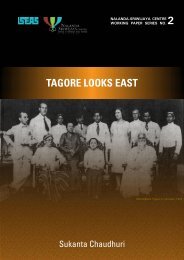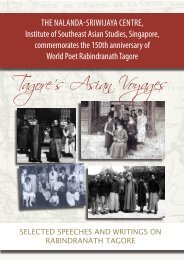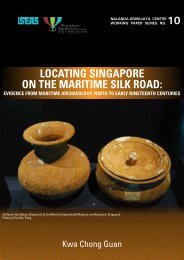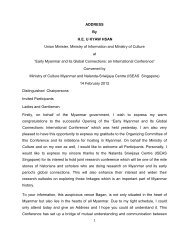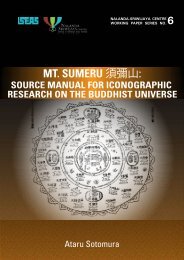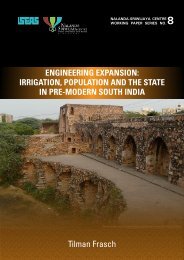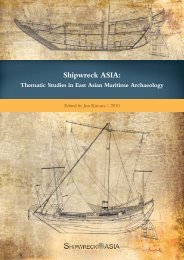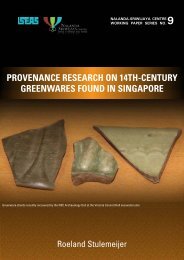Boni in Chinese Sources - Nalanda-Sriwijaya Centre - iseas
Boni in Chinese Sources - Nalanda-Sriwijaya Centre - iseas
Boni in Chinese Sources - Nalanda-Sriwijaya Centre - iseas
Create successful ePaper yourself
Turn your PDF publications into a flip-book with our unique Google optimized e-Paper software.
Kurz: <strong>Boni</strong> <strong>in</strong> Ch<strong>in</strong>ese <strong>Sources</strong> NSC Work<strong>in</strong>g Paper No. 4northwestern Borneo or Brunei. I th<strong>in</strong>k, however, that though camphor may be found <strong>in</strong>Borneo, the fact that it constituted part of the tribute presentation is not enough to anchor<strong>Boni</strong> firmly <strong>in</strong> or around Brunei Bay. The people of <strong>Boni</strong> might have acquired camphorthrough trade.The identification of the people <strong>in</strong>volved as Muslims is a legitimate speculation that startedwith the identification of Puyali as Abu Ali by Hirth and Rockhill. 23 Sh<strong>in</strong>u has been renderedby Jamil al‐Sufri as Sheikh Noh and Gex<strong>in</strong> as Qadhi Kassim, based on his read<strong>in</strong>g ofGroeneveldt’s translation of the entry on <strong>Boni</strong> <strong>in</strong> the Songshi. 24 With the same justificationwe may, however, also reta<strong>in</strong> the orig<strong>in</strong>al Ch<strong>in</strong>ese transcriptions to refer to <strong>in</strong>digenous non‐Muslim names.Puluxie (or Pu Luxie) certa<strong>in</strong>ly was not a Ch<strong>in</strong>ese 25 because his designation as fanren h<strong>in</strong>ts athis be<strong>in</strong>g either a Persian, an Arab, or more possibly even an Indian trader. The identity ofthe <strong>in</strong>terpreter Menggu rema<strong>in</strong>s mysterious as well, and it is impossible to tell <strong>in</strong> whichlanguage he conversed with the envoys. It is tempt<strong>in</strong>g to relate Menggu to the tribes ofsouthern Ch<strong>in</strong>a, namely the Man, and to hypothetically establish a l<strong>in</strong>guistic l<strong>in</strong>k of theseland‐based people with the visitors from overseas. However, with the very little <strong>in</strong>formationwe have, we can easily forego such assumptions.Interest<strong>in</strong>gly the envoys at no po<strong>in</strong>t <strong>in</strong> their description refer to <strong>Boni</strong> as be<strong>in</strong>g located on anisland, even though the sail<strong>in</strong>g directions given suggest an <strong>in</strong>sular location for the country.23 Chau Ju‐kua, 157.24 Jamil Al‐Sufri, Tarsilah Brunei: The Early History of Brunei up to 1432 AD (Bandar Seri Begawan: BruneiHistory <strong>Centre</strong>, 2000), 9. Chen Dasheng suggests S<strong>in</strong>a for Sh<strong>in</strong>u, Abu Ali for what he refers to as Buyali (Puyali),and Kasim for Gex<strong>in</strong>. See Chen Dasheng, “A Brunei Sultan <strong>in</strong> the Early 14 th Century: Study of an ArabicTombstone”, <strong>in</strong> Journal of Southeast Asian Studies 23.1 (1992): 11.25 Jamil Al‐Sufri addresses him as a “Ch<strong>in</strong>ese trader”. See Tarsilah Brunei, 9. Note that Chen addresses Puluxieas a “Ch<strong>in</strong>ese merchant” as well, and renders his name as Abu Ali. See Chen, “Brunei Sultan”, 11.7





